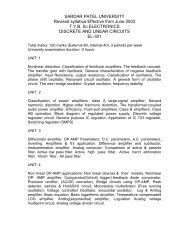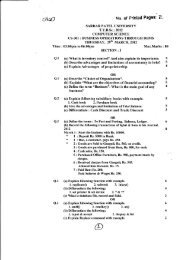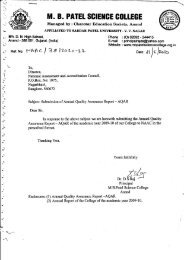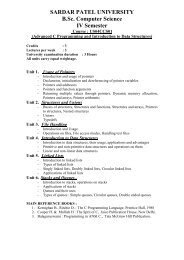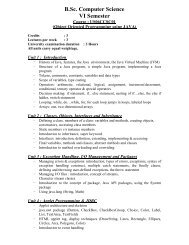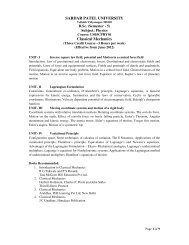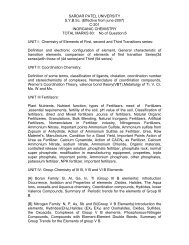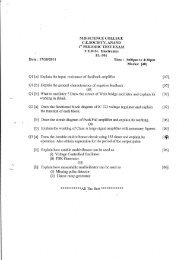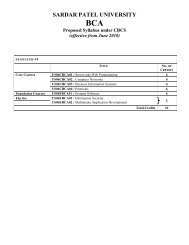SEMESTER III - MB Patel Science College
SEMESTER III - MB Patel Science College
SEMESTER III - MB Patel Science College
Create successful ePaper yourself
Turn your PDF publications into a flip-book with our unique Google optimized e-Paper software.
SARDAR PATEL UNIVERSITYS. Y. B. Sc. [Semester-IV]Syllabus of US04CCHE02 (APPLIED ASPECTS OF CHEMISTRY)[03 Credits](Effective from June-2011)Total Marks: 100 [30+70]Unit I : DIENES AND MACROMOLECULES[8Hrs.]Dienes: structure and properties, Resonance in conjugated dienes, Resonance inalkene. Hyperconjugation, Ease of formation of conjugated dienes. , Electrophilicaddition to conjugated dienes .1,4-addition, Free radical polymerization of dienes,Macromolecules , Polymer and polymerization, Free-radical vinyl polymerization,Copolymerization ,Ionic polymerization. Leaving group, Coordinationpolymerization, Step-reaction polymerization, Structure and properties ofmacromolecules.Unit II : Insecticides, Perfumes and Explosives[07Hrs.]Insecticides: Introduction to Insecticides, Classification of Insecticides, Synthesis andapplication of following Insecticides, DDT, BHC, Baygon, Malathion, Ferbum.Perfumes: Introduction to Perfumes, Vehicle or solvents, Fixatives, Synthesis andapplication of following Perfumes, Musk xylene, Coumarin, Vanilline, Heliotropian.Explosives: Introduction to Explosives, Classification of Explosives, Synthesis andapplication of following Explosives, Pentaerythritol, tetranitrate, Guanidian nitrate,RDX.Unit <strong>III</strong> : Vitamins[07Hrs.]Introduction to Vitamins, Classification and nomenclature of vitamins, Sources ofvitamins and their deficiency diseases, Precursors of vitamins, Biological functions ofvitamins, General structures of vitamins, Introduction, occurrence, physiologicalfunctions and synthesis (only Pommer’s second synthesis) of Vitamins A 1,Introduction, occurrence, physiological functions and synthesis of Vitamins A 2 ,Introduction, occurrence, physiological functions and synthesis (only Gorlich’ssynthesis) of Vitamins C. Introduction, occurrence, physiological functions andsynthesis (only Fieser’s synthesis) of Vitamins K 1 .Unit <strong>III</strong> : Fertilizers[07Hrs.]Plant Nutrients, Nutrient Function, Types of Fertilizers, Need of Fertilizers, EssentialRequirements, Fertility of the Soil, pH Value of the Soil, Classification of Fertilizer,Direct and Mixed Fertilizers, Source of Fertilizers, Natural Organic Fertilizers,Granulations, Bulk Blending, Natural Inorganic Fertilizers, Artificial Fertilizers,Nomenclature in Fertilizer Industry, Nitrogenous Fertilizers, Ammonium Nitrate,Important Points, Ammonium Sulfate, Ammonium Sulfate from Zypsum or Anhydride,Action of Ammonium Sulfate as Fertilizer, Urea, Raw Materials, Manufacture,Condition for a Good Yield, Important Points, Action of Urea as Fertilizer, CalciumCynamide, Action of CaCN 2 as Fertilizer, Calcium Ammonium Nitrate, Sodium Nitrate,Ammonium Chloride, Organic Materials, Controlled Release Nitrogen Solution,Phosphate Fertilizer, Phosphate Rock, Normal Super Phosphate, Modification inManufacturing Equipment, Properties, Triple Super Phosphate, Important Points,Ammonium Phosphate, Other Phosphates, Potassium Fertilizer, NPK Fertilizer,Important Fertilizers
SARDAR PATEL UNIVERSITYS. Y. B. Sc. [Semester-IV]Syllabus of US04CCHE03 (PRACTICAL CHEMISTRY)[03 Credits](Effective from June-2011)Total Marks: 100 [30+70]1. BINARY ORGANIC MIXTURE: [Solid + Solid or Solid + liquid i.e. (acetone, methylacetate, ethanol, benzene, CCl 4 )].2. VOLUMETRIC TITRATION (By self preparation of solution of titrant):(i) Determination of equivalent weight of carboxylic acid by alkali solution.(ii) Determination of glucose.(iii) Determination of formaldehyde by sodium hypoiodide.3. GRAVIMETRIC ANALYSIS(i) ZnCO3(ii) BaCl2.2 H2O4. Preparation of standard solutions.5. TLC and paper chromatography.6. VIVAVOCE
SARDAR PATEL UNIVERSITYS. Y. B. Sc. [Semester-IV]Syllabus of US04ECHE05 (INDUSTRIAL CHEMISTRY-II)[02 Credits](Effective from June-2011)Total Marks: 100 [30+70]Unit I : Introduction to Petroleum Technology[07Hrs.]Petroleum, Classification of petroleum, fractional distillation of crude oil, cracking,reforming, refining.Unit II : Industrial Fermentation[07Hrs.]Introduction, definition, cultural development, inoculums preparation, nutrients formicro organism, toxic effects on culture, manufacture of industrial alcohol byfermentation, Vinegar (Acetic acid ) and Penicillin-G.Unit <strong>III</strong> : Unit Processes in Organic Synthesis-I[08Hrs.]Nitration: Introduction, nitrating agents, Nitration of paraffinic hydrocarbon,manufacturing of nitrobenzene by batch & continuous process and o-/pnitrobenzene.Amination: (a) By reduction: Introduction and manufacturing of Aniline and m-nitroaniline.(b) By ammonolysis: Introduction and aminating agents.Chlorination: Introduction, Chlorinating agents and Photochlorination of CyclohexaneUnit IV : Unit processes in Organic Synthesis-II[08Hrs.]Sulphonation: Introduction, sulphonating agents, Benzene and its derivatives,manufacturing properties and uses of α- and β-naphthalene sulphonic acid.Oxidation: Introduction to types of oxidative reactions, oxidizing agents,manufacturing, preparation and uses of Formaldehyde, Phthalic anhydride and aceticacid.Esterification: Introduction, esterification by organic acid Esters by additions tounsaturated systems, manufacturing, properties & uses of Vinyl acetate.Reference Books :1. Modern Petroleum Refining Processes, 2 nd Edition, by B. K. Bhaskara Rao.2. Shreve’s Chemical Process Industries, 5 th Edition, by George T. Austin.3. Industrial Microbiology by A. H. <strong>Patel</strong> (Macmillan India Ltd.-New Delhi).4. Unit processes in organic synthesis, 5 th Edition, by P. H. Groggins.
SARDAR PATEL UNIVERSITYS. Y. B. Sc. [Semester-IV]US04ECHE06 (POLYMER CHEMISTRY)[02 Credits](Effective from June-2011)Total Marks: 100 [30+70]Unit I (A) : GENERAL INTRODUCTION[07 Hrs.]Introduction, Classification, Nomenclature of of polymers, Isomerism in of polymerchain.Synthetic Polymers: Introduction, Mechanism of polymerization., Coordinationpolymerization. , Ring opening polymerization.Unit I (B) : DIENES AND MACROMOLECULESDienes: structure and properties, Resonance in conjugated dienes, Resonance inalkene. Hyperconjugation, Ease of formation of conjugated dienes., Electrophilicaddition to conjugated dienes .1,4-addition, Free radical polymerization of dienes.Unit II : PHYSICAL PROPERTIES OF THE POLYMERS[08 Hrs.]Macromolecules, Polymer and polymerization, Free-radical vinyl polymerization,Copolymerization, Ionic polymerization. Leaving group, Coordination polymerization,Step-reaction polymerization, Structure and properties of macromolecules.Distinguishing features of addition and condensation polymerization, Copolymers,Phase system for polymerization like bulk, solution, emulsion and suspensionpolymerization, Clssification of polymers (1 to 3), Plastics and resins.Unit <strong>III</strong> : Inorganic Polymer[07 Hrs.]Introduction, Classification of inorganic polymers, General properties of inorganicpolymers, Polymers containing boron, silicon, phosphorous and sulphur.Unit V : Molecular weight determination[08 Hrs.]Cryoscopy, Ebulliometry, Membrane osmometry, End group analysis, Viscometry,Ultracentrifugation Light scattering.Reference Books :1. Principles of Polymer <strong>Science</strong> by P. Bahadur and N. V. sastry Page 1 to 14 and26 to 38.2. Organic chemistry by Morrison and Boyd, 6 th ed.3. Synthetic Organic Chemistry by Gurudeep R. Chatwal.4. Advanced inorganic chemistry Vol-1(19 th Edi)(Page:1085-1112) bySatyaprakash, G.D.Tuli, S.K.Basu and R.D.Madan.5. Polymer <strong>Science</strong>, First Edition 1986 reprint 2008 V.R.Gowariker,N.V.Viswanathan, Jayadevsreedhar (Page387-422).SARDAR PATEL UNIVERSITYS. Y. B. Sc. [Semester-IV]USO4ECHEO7 (Environmental Studies)
[02 Credits](Effective from June-2011)Total Marks: 100 [30+70]Unit I : Environmental Pollution[07 Hrs.]Introduction /origin, Environmental Pollution disasters, Mediterranean: A dead sea,Classification of pollutants. Air pollution, Composition of air, Chemical reaction in airdue to sun light, Reactions in Troposphere, Stratosphere and mesosphere. Smogformation in air. Major sources of air pollution, Other sources of air pollution, Units ofmeasurement of air pollutant Classification of air pollutants. Sulphur compounds aspollutants (a) Reaction of SO 2 in atm. (b) Effect of SO 2 on plant (c) Effect of SO 2 oncorrosion of Fe, Zn, Cu, Al.Unit II : Radioactive Pollution[08 Hrs.]Introduction, How radioactive pollution differ from other pollution. Types and unit ofradiation, Radiation chemistry, Interaction of ionising radiation with matter, PrincipalTypes of radiation, Chemical change, Effect of ionising radiation on water andaqueous solution, Effect of radiation on organic compound, Auto radiolysis, Naturalsources of radiation, Anthropogenic sources of radiation, Classification and effects ofradiation, Effect of ionizing & nonionizing radiation.Unit <strong>III</strong> : Water Pollutants and their properties[07 Hrs.]Introduction, Sources of water, Chemistry of water, Definition of water pollution,Types of water pollution including main point, Types of water pollution (four types),Types of water pollution based on sources and storages (Five types). Ground waterpollution, Factor affecting the ground water pollution, Effect of ground water pollutionon man and soil, Surface water pollution, Factors affecting the surface water, Sourcesof surface water pollution, Lake water pollution, Sources of pollutants in lake water.Unit IV : Soil Pollution[08 Hrs.]Introduction, Importance and formation of soil, Composition of soil, Salt affected to soil,Sources of soil pollution, Soil erosion and its types, Agents of soil erosion, Mechanismof soil erosion, Factors affecting to soil erosion, Detrimental effects of soil erosion,Measures of soil erosion, Preventing soil erosion, Chemical method of SEWAGETreatment, Control of soil pollution, Sources using wastes.Reference Books :1. Environmental studies by S.V.S Rana Second reprint (F. Edi):2007.2. Environmental Chemistry by B. K. Sharma, H.KAUR, Third revised and enlargededition -1996-97.



